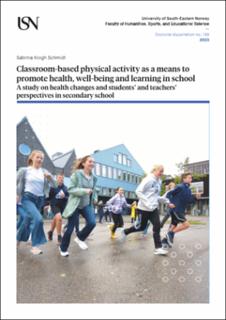| dc.contributor.author | Schmidt, Sabrina Krogh | |
| dc.date.accessioned | 2023-01-18T14:22:31Z | |
| dc.date.available | 2023-01-18T14:22:31Z | |
| dc.date.issued | 2023-02-02 | |
| dc.identifier.isbn | 978-82-7206-740-2 | |
| dc.identifier.issn | 2535-5252 | |
| dc.identifier.uri | https://hdl.handle.net/11250/3044389 | |
| dc.description.abstract | Background: Schools have been identified as a key setting for promoting physical activity. The relation of physical activity to cognitive function and academic achievement in primary school has received considerable attention. Less focus has been given to the secondary school setting and students’ psychosocial well-being. The aim of this Ph.D. study was to explore how students’ health and well-being are influenced when classroom-based physical activity is implemented into curriculum teaching. The thesis examines how this affects physical activity levels, physical fitness and well-being, and explores students’ and teachers’ experiences of classroom-based physical activity with a focus on psychosocial well-being.
Method: The study was conducted in two phases. 1) Changes in student levels were assessed using a quasi-experimental design with pre/post-tests of physical activity levels, BMI and questionnaires on health-related quality of life and vitality (well-being) on 644 students in 8th grade. 2) Student and teacher lived experiences of the classroom-based physical activity were explored through a descriptive phenomenological study using in-depth individual interviews with nine students and six teachers.
Results: Nine months after implementing classroom-based physical activity, students at intervention schools had improved their physical fitness and were more physically active in school time than students at control schools. Further, in female students, there was a greater positive difference in health-related quality of life outcomes. The students’ shared experiences were that classroom-based physical activity was a valued and meaningful movement activity that improved their psychosocial well-being at school. The teachers’ shared experiences were that classroom-based physical activity was relevant, yet more complex than expected, in secondary school settings. This experience resulted in the loss of motivation and resorting to simpler solutions with a potential loss of the coherence of the approach.
Conclusion: Classroom-based physical activity can benefit students’ health and well-being mostly by counteracting an expected reduction. Especially female students seemed to benefit from the initiative by reporting more stable levels of psychosocial health and well-being. While students in general support and welcome classroom-based physical activity, some found the competitive focus demanding. Teachers seem to struggle to implement and apply the approach in a regular and meaningful way that supports the implementation of more physical activity and academic learning objectives. Support and focus on teachers’ professional development are critical for physically active learning to become a regular part of subject teaching in secondary school. | en_US |
| dc.language.iso | eng | en_US |
| dc.publisher | University of South-Eastern Norway | en_US |
| dc.relation.haspart | Article 1: Schmidt, S.K., Reinboth, M.S., Resaland, G.K. & Bratland-Sanda, S.: Changes in physical activity, physical fitness and well-being following a school-based health promotion program in a Norwegian region with poor public health profile: A non-randomized controlled study in early adolescents. International Journal of Environmental Research and Public Health, 17(3), (2020), 896. https://doi.org/10.3390/ijerph17030896 | en_US |
| dc.relation.haspart | Article 2: Schmidt, S.K., Bratland-Sanda, S. & Bongaardt, R.: Young adolescents’ lived experience with teacher-led classroom-based physical activity: A phenomenological study. Teaching and Teacher Education, 116, (2022), 103777. https://doi.org/10.1016/j.tate.2022.103777 | en_US |
| dc.relation.haspart | Article 3: Schmidt, S.K., Bratland-Sanda, S. & Bongaardt, R.: Secondary school teachers' experiences with classroom-based physically active learning: “I'm excited, but it's really hard”. Teaching and Teacher Education, 116, (2022), 103753. https://doi.org/10.1016/j.tate.2022.103753 | en_US |
| dc.rights.uri | http://creativecommons.org/licenses/by-nc-sa/4.0/deed.en | |
| dc.subject | school-based physical activity | en_US |
| dc.subject | classroom-based physical activity | en_US |
| dc.subject | physically active learning | en_US |
| dc.subject | physical activity breaks | en_US |
| dc.subject | secondary school | en_US |
| dc.subject | physical activity | en_US |
| dc.subject | psychosocial well-being | en_US |
| dc.subject | students’ perspective | en_US |
| dc.subject | teachers’ perspective | en_US |
| dc.title | Classroom-based physical activity as a means to promote health, well-being and learning in school. A study on health changes and students’ and teachers’ perspectives in secondary school | en_US |
| dc.type | Doctoral thesis | en_US |
| dc.description.version | publishedVersion | en_US |
| dc.rights.holder | © The Author, except otherwise stated | en_US |

